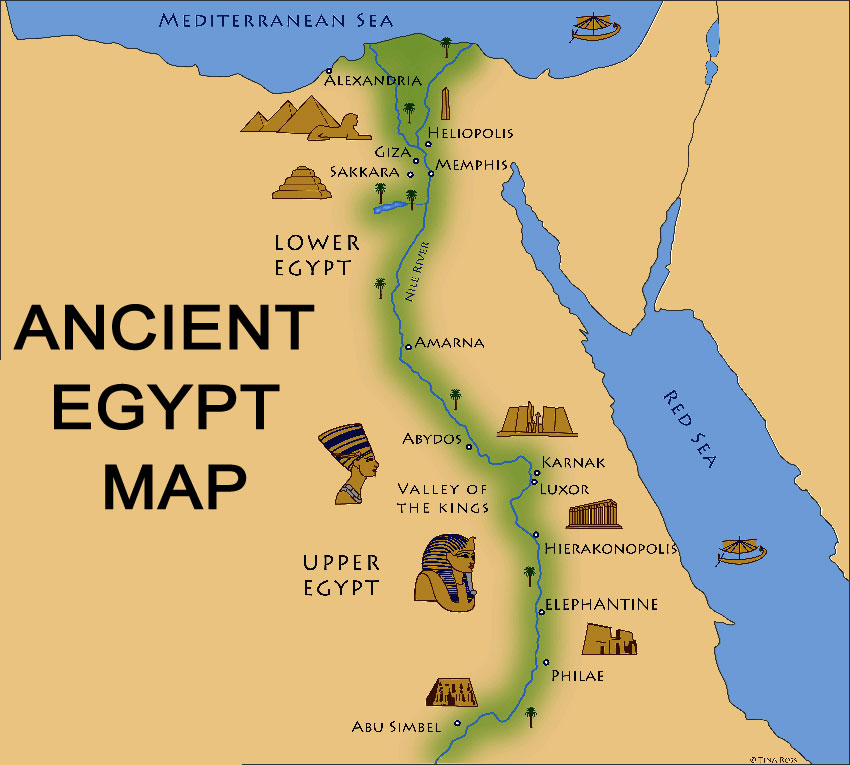Ancient Egypt Map
Civilization Cities, and Empire
Introduction
Ancient Egypt has long captured the imagination of historians, travelers, and researchers alike. From the majestic pyramids to the flowing Nile River, the geography of Egypt played a central role in shaping one of the world’s most remarkable civilizations. Maps of Ancient Egypt are not just historical records; they are vital tools that help us visualize the growth of its empire, the spread of its culture, and the locations of its iconic cities. This article explores different types of Ancient Egypt maps, from empire expansions to city layouts, and highlights their importance in understanding the legacy of Egyptian civilization.
Table of Contents
Map of Ancient Egypt
The map of Ancient Egypt is more than a geographic tool—it is a window into one of the most influential civilizations in human history. By examining the Nile River, deserts, and fertile lands, we can understand why Egypt thrived for thousands of years. The river shaped agriculture, trade, and settlement patterns, forming the foundation of Egyptian culture and power.
Ancient Egyptian Empire Map
The Ancient Egyptian empire map illustrates the growth of Egypt from a local kingdom to a vast regional power. During the New Kingdom, Egypt expanded south into Nubia and north into the Levant, creating a stronghold of influence. These maps reveal military campaigns, trade routes, and the political control that defined Egypt’s golden age.
Map of ancient Egypt
Ancient Egyptian empire map
Map of Egyptian civilization
Map of Egyptian empire
Map of the ancient Egyptian
Ancient Egypt city map
Ancient Egypt civilization map
Old map of ancient Egypt
Ancient Egypt Map
Old Egypt map
Map ancient Egypt
Map of Egypt ancient
A map of Egyptian civilization helps us trace the spread of culture, writing, and religion. Hieroglyphic inscriptions across temples, pyramids, and monuments correspond to specific locations on the map. This visual link between place and culture allows researchers to see how art, architecture, and daily life were organized geographically.
Map of Egyptian Empire
The map of the Egyptian empire highlights the strategic role of the Nile as a lifeline for expansion. It shows Egypt’s ability to integrate neighboring lands while maintaining cultural identity. Unlike other empires, Egypt balanced conquest with cultural preservation, which is visible in maps that trace both trade and military routes.
Map of the Ancient Egyptian
A map of the Ancient Egyptian world gives insights into how Egyptians saw themselves in relation to their neighbors. It marks boundaries between Upper and Lower Egypt, major cities, and sacred sites. This map also reveals the Egyptians’ deep connection to the Nile as a spiritual as well as economic source of life.
Map of ancient Egypt
Ancient Egyptian empire map
Map of Egyptian civilization
Map of Egyptian empire
Map of the ancient Egyptian
Ancient Egypt city map
Ancient Egypt civilization map
Old map of ancient Egypt
Ancient Egypt Map
Old Egypt map
Map ancient Egypt
Map of Egypt ancient
Ancient Egypt City Map
The Ancient Egypt city map displays centers such as Memphis, Thebes, and Alexandria. These cities were hubs of administration, culture, and religion. Maps of cities provide a closer look at urban planning, temples, and the placement of monumental structures like the Great Pyramids and Karnak Temple.
Ancient Egypt Civilization Map
A civilization map of Ancient Egypt emphasizes not just land but culture, philosophy, and daily life. It covers the areas where Egyptians built temples, developed irrigation systems, and cultivated their distinct identity. By mapping these aspects, historians show how Egypt became a cornerstone of world civilization.
Map
of ancient Egypt
Ancient Egyptian empire map
Map of Egyptian civilization
Map of Egyptian empire
Map of the ancient Egyptian
Ancient Egypt city map
Ancient Egypt civilization map
Old map of ancient Egypt
Ancient Egypt Map
Old Egypt map
Map ancient Egypt
Map of Egypt ancient
An old map of Ancient Egypt reveals how explorers and early historians understood this civilization. From Greek geographers to medieval cartographers, these maps often combined myth and reality. While not always accurate, they provide fascinating insight into how Egypt was imagined across centuries.
Ancient Egypt Map
Today’s Ancient Egypt map combines modern archaeology with historical geography. Digital reconstructions allow us to see how borders, cities, and cultural regions evolved. With interactive maps, students and travelers alike can explore the landmarks of Ancient Egypt virtually.
Conclusion
The maps of Ancient Egypt—whether of its empire, cities, or civilization—are essential for understanding how this culture shaped human history. They provide geographical context to the rise of dynasties, the spread of culture, and the endurance of traditions. By studying them, we gain not only knowledge of the past but also a deeper appreciation of Egypt’s role in shaping the world. For a more detailed look at authentic cartography, you can explore this comprehensive Ancient Egypt map resource.
FAQs about Ancient Egypt Maps
Why are maps important in studying Ancient Egypt?
Maps are essential for understanding the geography, culture, and political expansion of Ancient Egypt. They show the role of the Nile, the spread of cities, and the empire’s influence.
What does an Ancient Egyptian empire map show?
It illustrates Egypt’s expansion into Nubia and the Levant during the New Kingdom, highlighting trade, military campaigns, and cultural integration.
Which cities appear on Ancient Egypt maps?
Cities like Memphis, Thebes, and Alexandria are featured, as they were major hubs of politics, religion, and culture.
Where can I explore Ancient Egypt maps online?
You can explore detailed maps at this Ancient Egypt maps resource.




